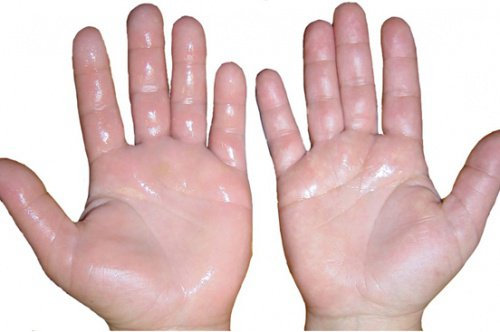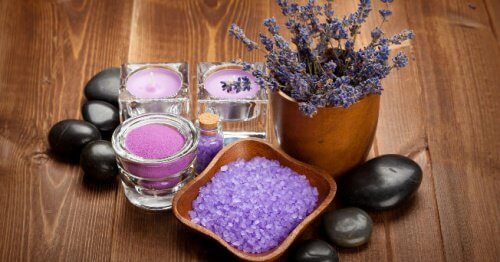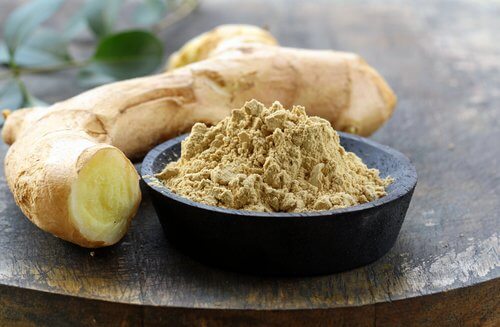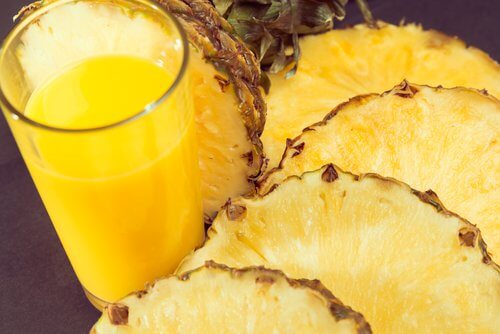6 Home Remedies for Swollen Hands

There are a lot of different reasons that people might suffer from swollen hands. It could be due to a stroke, a problem with circulation, arthritis, carpal tunnel syndrome, or just an insect bite. Regardless of the cause, however, in today’s article, we want to suggest some home remedies that will help reduce that painful swelling.
Home remedies for swollen hands
Our ancestors probably knew of lots of home remedies for reducing swelling in the hands, whether it was caused by a sports injury, poor circulation, allergies, insect bites, stroke, arthritis, or something else.
When your hands are swollen, the blood can’t circulate properly. It’s a painful condition that can keep you from performing your normal activities. That’s why it’s always a good idea to always have one of the following treatments on hand.
Lavender
This is a beautiful plant known for its color and scent. Lucky for us, it also has numerous medicinal properties. Let’s take a look at some of the health benefits of lavender:
- It is a relaxant.
- Lavender invigorates the nervous system.
- It fights spasms and can relieve pain.
- It has antibacterial properties.
- Lavender is a natural antiseptic.
- Lavender is a natural antidepressant and can improve your mood.
You might like: How to Make Homemade Lavender Soap
You can make a lavender compress for swollen hands using the following ingredients:
- ½ cup of dried lavender flowers
- ½ cup of dried, crushed sage
- 2 cups of water (400 ml)
- 8 drops of lavender essential oil

Add the water, flowers, and sage to a saucepan and bring to a gentle simmer for 20 minutes, covered. Strain the liquid into a container and allow it to cool. Add the lavender essential oil and stir well.
Apply this mixture to your swollen hand using either a cotton cloth or a wrap. The used herbs can be wrapped in a paper towel and placed over the affected area as well, just press them gently to release the liquid.
Another way to use lavender is to take a relaxing bath for full-body immersion. You can also make a soak for just the hands in a smaller container. All you need is:
- 3 tablespoons of lavender flowers (dried)
- 1 ½ cup of milk
- 1/3 cup of honey
Crush the lavender flowers using a food processor or a mortar and pestle until they’re very fine. Mix them with the milk and honey, then pour everything into a glass container. Shake well before using. If you’re using this for the bath, add half of the liquid to your bath water. Only use a quarter of the container for just soaking your hands. You can store it in the fridge for up to a week.
Ice
This can be your best friend if you’re experiencing swelling in any part of the body, particularly of the hands. Ice is great for reducing inflammation.
You can make a compress using some crushed ice or by wrapping several ice cubes in a towel. Just be sure to never apply ice directly to your skin because it could burn you. Repeat this several times a day, but don’t leave it on for more than 20 minutes at a time.
Ginger
Read more: Ginger Remedy for Joint Pain
Ginger is well known for its ability to treat inflammation, which is one of the many reasons it has been used in herbal medicine for centuries. It alleviates pain, thins the blood, reduces inflammation, and more.
You can make a ginger tea using a teaspoon of grated or powdered ginger root per cup of boiling water. If you want to sweeten it, add a little honey. For flavor, try some freshly squeezed lemon juice.
 Aloe vera
Aloe vera
Aloe is a fantastic option for any problems that concern the skin, and it can even be helpful if you are suffering from swollen hands. For example, some athletes make compresses using aloe vera when they’re injured or after they compete to provide relief for their muscles because it helps them recover more quickly.
Everyone should have an aloe plant in the home so that it’s easy to cut off one of the leaves and use the fresh juice. Apply it directly to the affected area and you’ll feel immediate relief. It’s also excellent for taking the sting out of insect bites.
Pineapple
This is one of the most useful fruits when it comes to reducing inflammation in the hands. We recommend eating some pineapple every day for a week to alleviate your pain. Remember that you can always enjoy it in different baked goods or add a slice or two to sweeten a tart salad. It’s a delicious, and potent, remedy.
 Marigolds
Marigolds
This remedy can be used both topically (externally) and internally to treat swollen hands. To use it topically, make a compress using orange and red marigolds and apply it to the affected area. The other option is to make a tea using a handful of the dried flower petals and a cup of boiling water. After it steeps for five minutes, strain off the liquid, sweeten it and enjoy both the unique taste as well as the benefits.
Foods with vitamin B6
This particular vitamin is known for its ability to reduce inflammation, especially for people who suffer from carpal tunnel syndrome in the wrist. Some of the foods that are high in vitamin B6 are potatoes, brown rice, green leafy vegetables (spinach, chard, lettuce), bananas, and skinless chicken breast. It’s a good idea to add these to your daily diet and try them in various recipes and dishes. They’ll help you feel better – both inside and out.
All cited sources were thoroughly reviewed by our team to ensure their quality, reliability, currency, and validity. The bibliography of this article was considered reliable and of academic or scientific accuracy.
- How does the hand work? (2010).
ncbi.nlm.nih.gov/books/NBK279362/ - da Silva, G. L., Luft, C., Lunardelli, A., Amaral, R. H., da Silva Melo, D. A., Donadio, M. V. F., … de Oliveira, J. R. (2015). Antioxidant, analgesic and anti-inflammatory effects of lavender essential oil. Anais Da Academia Brasileira de Ciencias. https://doi.org/10.1590/0001-3765201520150056
- Grzanna, R., Lindmark, L., & Frondoza, C. G. (2005). Ginger—An Herbal Medicinal Product with Broad Anti-Inflammatory Actions. Journal of Medicinal Food. https://doi.org/10.1089/jmf.2005.8.125
- Chandran Preethi, K., Kuttan, G., & Kuttan, R. (2009). Anti-inflammatory activity of flower extract of Calendula officinalis Linn. and its possible mechanism of action. Indian Journal of Experimental Biology.
- Azócar, G. (2004). Patologia tendinea, vascular y tumoral de la mano: hallazgos ultrasonograficos. Revista chilena de radiología, 10(2), 72-80. https://scielo.conicyt.cl/scielo.php?script=sci_arttext&pid=S0717-93082004000200006
- Lombos, M. F., & Rodríguez, J. P. (2002). Síndrome del túnel carpiano: breve revisión, discusión y experiencia personal. Rehabilitación, 36(5), 293-298. https://www.sciencedirect.com/science/article/abs/pii/S0048712002732945
- Cardia, G. F. E., Silva-Filho, S. E., Silva, E. L., Uchida, N. S., Cavalcante, H. A. O., Cassarotti, L. L., … & Cuman, R. K. N. (2018). Effect of lavender (Lavandula angustifolia) essential oil on acute inflammatory response. Evidence-Based Complementary and Alternative Medicine, 2018. https://www.ncbi.nlm.nih.gov/pmc/articles/PMC5878871/
- Ghorbani, A., & Esmaeilizadeh, M. (2017). Pharmacological properties of Salvia officinalis and its components. Journal of traditional and complementary medicine, 7(4), 433-440. https://www.ncbi.nlm.nih.gov/pmc/articles/PMC5634728/
- Espinoza, H. G., Bustamante, I. L., & Pérez, S. M. (2010). Revisión sistemática sobre el efecto analgésico de la crioterapia en el manejo del dolor de origen músculo esquelético. Revista de la Sociedad Española del Dolor, 17(5), 242-252. http://scielo.isciii.es/scielo.php?script=sci_arttext&pid=S1134-80462010000500005
- Tillán Capó, J., Nuñez Figueredo, Y., Agüero Fernández, S., & Carrillo Domínguez, C. (2007). Actividad antiinflamatoria de compuestos liposolubes de Zingiber officinale Roscoe frente a diferentes agentes flogísticos. Revista Cubana de Plantas Medicinales, 12(2), 0-0. http://scielo.sld.cu/scielo.php?script=sci_arttext&pid=S1028-47962007000200005
- Gómez-Rodríguez, B. T., Cortés Suárez, S., & Izquierdo-Sánchez, T. (2013). Efecto del extracto hidroalcohólico de Zingiber officinale Roscoe (jengibre) en modelo de hepatotoxicidad en ratas. Revista Cubana de Plantas Medicinales, 18(3), 431-444. http://scielo.sld.cu/scielo.php?script=sci_arttext&pid=S1028-47962013000300010
- Rodríguez Domínguez, I., Santana Gutiérrez, O., Recio López, O., & Fuentes Naranjo, M. (2006). Beneficios del Aloe Vera l.(sábila) en las afecciones de la piel. Revista Cubana de Enfermería, 22(3), 0-0. http://scielo.sld.cu/scielo.php?script=sci_arttext&pid=S0864-03192006000300004
- Rathnavelu, V., Alitheen, N. B., Sohila, S., Kanagesan, S., & Ramesh, R. (2016). Potential role of bromelain in clinical and therapeutic applications. Biomedical reports, 5(3), 283-288. https://www.ncbi.nlm.nih.gov/pmc/articles/PMC4998156/
- Fang Mercado, L., Herrera Herrera, A., & Díaz Caballero, A. (2013). Enjuagues de Calendula officinalis como alternativa de los antisépticos orales. Revista cubana de Estomatologia, 50(4), 436-442. http://scielo.sld.cu/scielo.php?script=sci_arttext&pid=S0034-75072013000400010
This text is provided for informational purposes only and does not replace consultation with a professional. If in doubt, consult your specialist.








